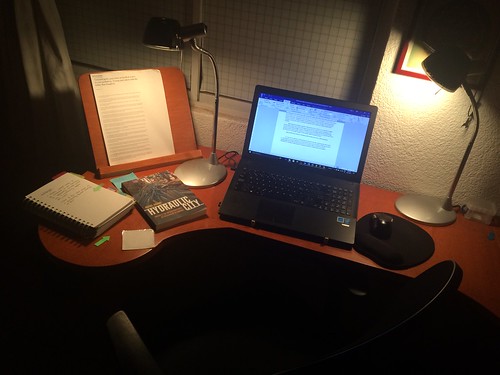I find it slightly ironic that I am writing these blog posts to guide my doctoral students when a few of them have already graduated and I have two so close to completing their dissertations.
I recently came to realize that a lot of students want to write their dissertations or theses AFTER some randomly decided milestone: after they are done their fieldwork. After they’ve collected all the necessary datasets. After they’ve finished archival work. After they’ve completed the literature review. From my own experience as a doctoral student and as someone who now supervises PhD candidates (as well as other thesis’ students), I can tell you that there is no perfect day to start writing your thesis.
My advice to my own students and anybody who will listen to me is always: “start writing the minute you start your degree”.
As I mentioned on Twitter, I know that different thesis and dissertation advisors will have varied opinions on when students should start writing. So what I am describing here is what I did and what my approach with my own students is.
On the thesis/dissertation structure
Contrary to other colleagues in my cohort, I did not rewrite my comprehensive exams’ papers to become chapters of my dissertation. I wrote a book-manuscript-style dissertation, though my advisor was very much intent on the three-paper model. My dissertation research could have gone either way, but we did not want to redraw my work altogether to build individual papers before submitting the dissertation to the external examiner.
We compromised in the following way:
- I wrote a book-style dissertation with 3 empirical chapters that, standing on their own, would give me each a theoretical or an empirical contribution.
- I was free to do a full literature review chapter if I wanted to, and a full-fledged historical overview chapter.
- My advisor and I agreed that the introductory and concluding chapters should read like any book manuscript (you should read William Germano’s “From Dissertation to Book” for what’s perhaps the best guidance on turning a book-manuscript-style dissertation into a book, but also search for guidance on how to write introductions and conclusions there).
Most of MY PhD students’ dissertations read as follows (I ask them to develop their three-papers’ model with their Dissertation Analytical Table (DAT):
- Introduction/set up/review of the literature/where my students’ thesis contributes and how/structure of the dissertation/summary of chapters
- Paper 1
- Paper 2
- Paper 3
- Conclusions/future research/limitations
Mine looks a bit like this one, with a historical chapter as chapter 2. But as I was writing it, when I developed my framework, I realized each one of the 3 elements of my framework could be framed as a stand-alone paper, so I wrote it as Element 1, Element 2, Element 3.
Many doctoral students I know will write a very long dissertation proposal/prospectus from where they can extract material for their dissertations. That’s what I did with mine. My prospectus was a mini-dissertation. I just had to expand with the 3 empirical examples.
So, when do I start writing my dissertation/thesis?
For ALL my doctoral students, the moment when they need to start writing the doctoral dissertation is when their Dissertation Two Pager (DTP), their Dissertation Analytical Table (DAT) and their Global Dissertation Narrative (GDN} present a coherent, cohesive body of work. That means, that their Red Thread/Throughline/Conductive Thread can be easily detected.
… idea that my prospectus, expanded, would become my full-fledged doctoral dissertation.
In summary: I don’t think there’s a perfect moment where you can wake up, and say “it’s February 15, I am going to start writing my PhD dissertation”. I think you can always write…
— Dr Raul Pacheco-Vega (@raulpacheco) February 17, 2020
Important for those of you who do experiments/fieldwork/archival work:
When you plan progress of your dissertation research and you build your Gantt Chart https://t.co/YLCm2x6AMW using backcasting techniques https://t.co/wAmyejeoa0 you need to account for “time to assemble”.
— Dr Raul Pacheco-Vega (@raulpacheco) February 17, 2020
As I said on my Twitter thread, it is useful to write bits and pieces of the dissertation as the research progresses.
On content and structure, simultaneously: Make time for the final assembly, and revisit the Red Thread/Throughline/Conductive Thread.
When you finally have completed experiments, fieldwork, data collection, archival work, you probably want to sit down and write everything up. But once you’ve written all of your analysis up, you still need time to ASSEMBLE the final product and create the Red Thread/Throughline.
(This process looks exactly the same when you’re writing a full book manuscript even if it’s not your doctoral dissertation – it also works similarly for an undergrad or Masters thesis). The assemblage process is important because that’s where you give coherence to your work.
Germano on “From Dissertation to Book” https://t.co/bSxVOEtPzx and @PJDunleavy ‘s Authoring a PhD Thesis https://t.co/0UIyI3Q7n0 should be required reading if you’re doing a book-style thesis.
If you’re writing a 3-papers-thesis, I recommend @ThomsonPat and Kamler and …
— Dr Raul Pacheco-Vega (@raulpacheco) February 17, 2020
Belcher’s #12WeeksArticle.
My post on Thomson and Kamler https://t.co/vvvirqPfrY Writing for Peer Reviewed Journals
My post on Belcher’s 1st edition https://t.co/vvvirqPfrY (there’s a 2nd edition out now, you should read that one too).
Overall, let me re-emphasize this:
— Dr Raul Pacheco-Vega (@raulpacheco) February 17, 2020
YOU NEED CONSTANT CONTACT WITH AND FEEDBACK FROM YOUR SUPERVISOR (AND SUPERVISORY COMMITTEE).
There is absolutely no substitute for a conversation with your supervisor. No matter how many books on “how to PhD” you read, you need to be in constant conversation and communication.
A note to PhD advisors: I have heard from MANY graduate students all over the world, wherever I go and give talks, that they don’t get much/enough feedback/lack a lot of bi-directional communication – this is very important – students need your feedback and your sign-off on their theses.
In conclusion:
In this blog post I described how I wrote my doctoral dissertation and how my own doctoral students write theirs. Every supervisor/lab/student have their own processes and idiosyncracies. What I think is always important is to maintain open and constant communication between student and advisor.





Your site and articles consist of very motivating and useful information.Thank you for sharing your experiences and knowledge. If you had prepared a study program for a person working on a full-time doctoral thesis, how many hours per day would you suggest that devote time to reading, taking notes and writing? Or at least how many words should have written a day.